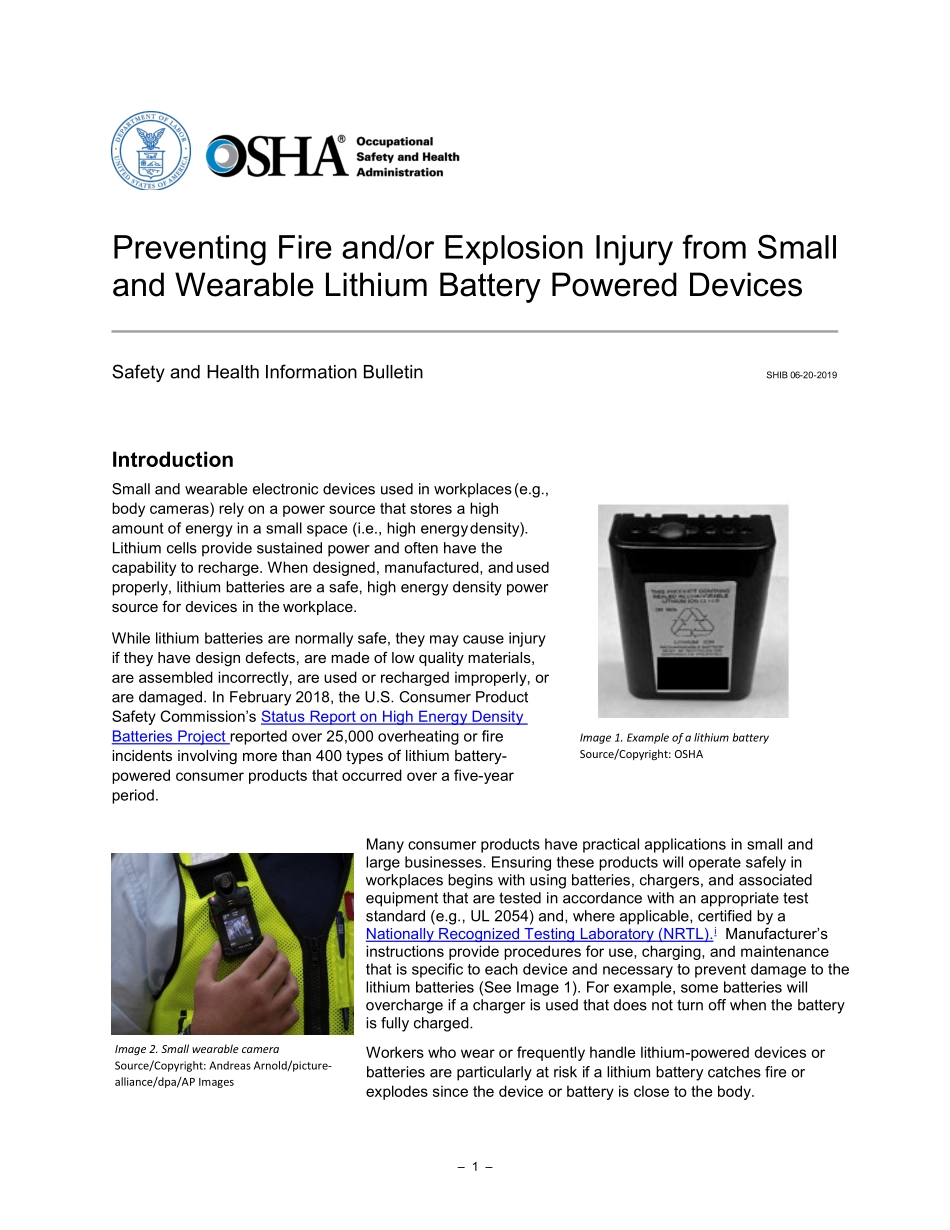–1–PreventingFireand/orExplosionInjuryfromSmallandWearableLithiumBatteryPoweredDevicesSafetyandHealthInformationBulletinSHIB06-20-2019IntroductionSmallandwearableelectronicdevicesusedinworkplaces(e.g.,bodycameras)relyonapowersourcethatstoresahighamountofenergyinasmallspace(i.e.,highenergydensity).Lithiumcellsprovidesustainedpowerandoftenhavethecapabilitytorecharge.Whendesigned,manufactured,andusedproperly,lithiumbatteriesareasafe,highenergydensitypowersourcefordevicesintheworkplace.Whilelithiumbatteriesarenormallysafe,theymaycauseinjuryiftheyhavedesigndefects,aremadeoflowqualitymaterials,areassembledincorrectly,areusedorrechargedimproperly,oraredamaged.InFebruary2018,theU.S.ConsumerProductSafetyCommission’sStatusReportonHighEnergyDensityBatteriesProjectreportedover25,000overheatingorfireincidentsinvolvingmorethan400typesoflithiumbattery-poweredconsumerproductsthatoccurredoverafive-yearperiod.Image1.ExampleofalithiumbatterySource/Copyright:OSHAImage2.SmallwearablecameraSource/Copyright:AndreasArnold/picture-alliance/dpa/APImagesManyconsumerproductshavepracticalapplicationsinsmallandlargebusinesses.Ensuringtheseproductswilloperatesafelyinworkplacesbeginswithusingbatteries,chargers,andassociatedequipmentthataretestedinaccordancewithanappropriateteststandard(e.g.,UL2054)and,whereapplicable,certifiedbyaNationallyRecognizedTestingLaboratory(NRTL).iManufacturer’sinstructionsprovideproceduresforuse,charging,andmaintenancethatisspecifictoeachdeviceandnecessarytopreventdamagetothelithiumbatteries(SeeImage1).Forexample,somebatterieswilloverchargeifachargerisusedthatdoesnotturnoffwhenthebatteryisfullycharged.Workerswhowearorfrequentlyhandlelithium-powereddevicesorbatteriesareparticularlyatriskifalithiumbatterycatchesfireorexplodessincethedeviceorbatteryisclosetothebody.–2–Forexample,smallcameraswornbyworkers(e.g.,policeandsecuritypersonnel),asshowninImage2,cancauseburnsorotherseriousinjuryifthelithiumbatterycatchesfireorexplodeswhileworn.Topreventinjury,itisimportantforemployersandworkerstounderstandalithium-powereddevice’sbasicfunction,hazards,andsafeuse.HowLithiumBatteriesWorkTheterm“lithiumbattery”referstooneormorelithiumcellsthatareelectricallyconnected.Likeallbatteries,lithiumbatterycellscontainapositiveelectrode,anegativeelectrode,aseparator,andanelectrolytesolution.Atomsormoleculeswithanetelectriccharge(i.e.,ions)aretransferredfromapositiveelectrodetoanegativeelectrodethroughanelectrolytesolution.Lithiumcellsstoreandreleasepowerbyconvertingchemicalpotentialenergyintoelectricalenergyusinglithiumionsorlithiummetal.Electrolytesolutionsallowionstoflowfreelybetweentheelectrodes.Lithium-ionbatteriesuselithiuminionicforminsteadoflithiuminsolidmetallicform(SeeImage3).Theyarealsousuallyrechargeable,oftenwithouttheneedtoremovethemfromthedevice.Lithium-ionbatteriespowerdevicessuchasmobiletelephones,laptopcomputers,tablets,cameras,andpowertools.Lithium-metalbatteriesaregenerallynon-rechargeableandhavelithium-metalelectrodes.Lithium-metalbatteriesaregenerallyusedtopowerdevicessuchaswatches,calculators,temperaturedataloggers,carkeyfobs,flashlights,anddefibrillators.HazardsLithiumbatteriesaregenerallysafeandunlikelytofail,butonlysolongastherearenodefectsandthebatteriesarenotdamaged.Whenlithiumbatteriesfailtooperatesafelyoraredamaged,theymaypresentafireand/orexplosionhazard.Damagef...



 优质VIP
优质VIP 优质VIP
优质VIP 优质VIP
优质VIP 优质VIP
优质VIP 优质VIP
优质VIP 优质VIP
优质VIP 优质VIP
优质VIP 优质VIP
优质VIP 优质VIP
优质VIP 优质VIP
优质VIP